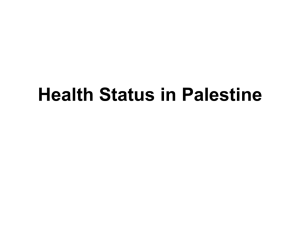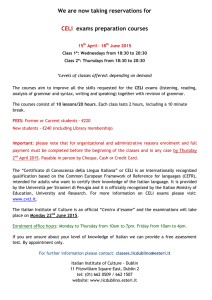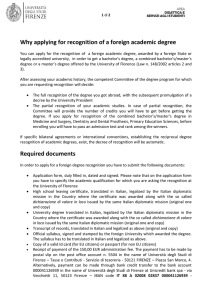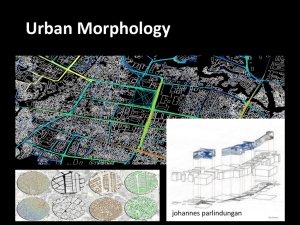Table No. (2) shows the distribution of urgent small deliveries to
advertisement
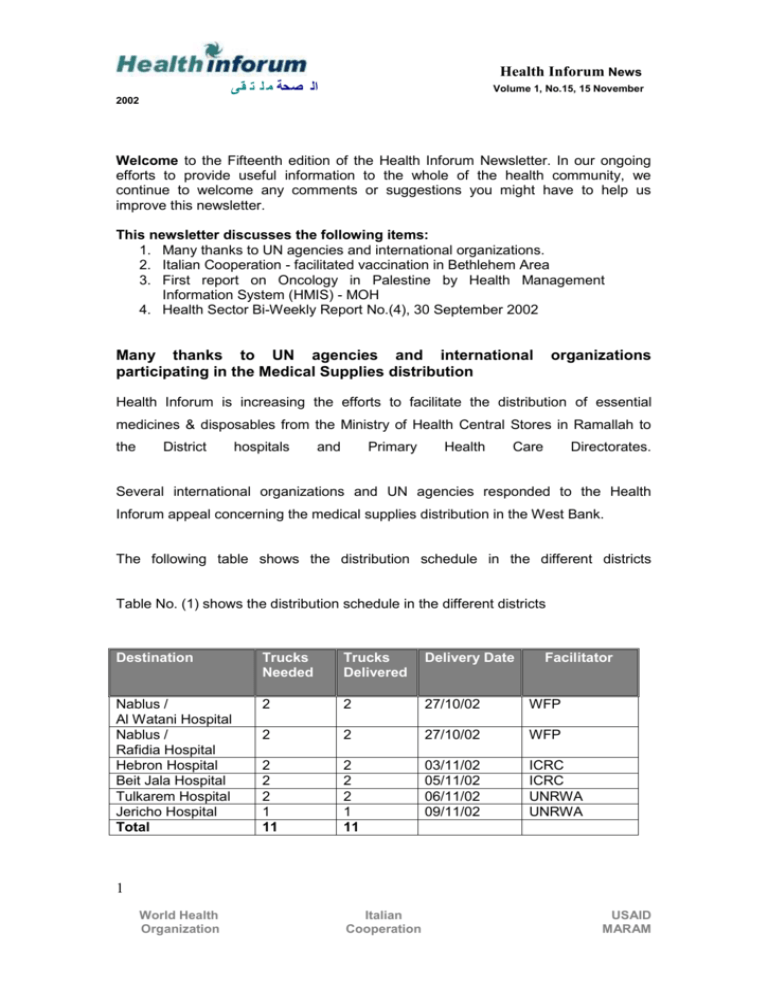
Health Inforum News ال صحة م ل ت قى Volume 1, No.15, 15 November 2002 Welcome to the Fifteenth edition of the Health Inforum Newsletter. In our ongoing efforts to provide useful information to the whole of the health community, we continue to welcome any comments or suggestions you might have to help us improve this newsletter. This newsletter discusses the following items: 1. Many thanks to UN agencies and international organizations. 2. Italian Cooperation - facilitated vaccination in Bethlehem Area 3. First report on Oncology in Palestine by Health Management Information System (HMIS) - MOH 4. Health Sector Bi-Weekly Report No.(4), 30 September 2002 Many thanks to UN agencies and international participating in the Medical Supplies distribution organizations Health Inforum is increasing the efforts to facilitate the distribution of essential medicines & disposables from the Ministry of Health Central Stores in Ramallah to the District hospitals and Primary Health Care Directorates. Several international organizations and UN agencies responded to the Health Inforum appeal concerning the medical supplies distribution in the West Bank. The following table shows the distribution schedule in the different districts Table No. (1) shows the distribution schedule in the different districts Destination Trucks Needed Trucks Delivered Delivery Date Fa Facilitator Nablus / Al Watani Hospital Nablus / Rafidia Hospital Hebron Hospital Beit Jala Hospital Tulkarem Hospital Jericho Hospital Total 2 2 27/10/02 WFP 2 2 27/10/02 WFP 2 2 2 1 11 2 2 2 1 11 03/11/02 05/11/02 06/11/02 09/11/02 ICRC ICRC UNRWA UNRWA 1 World Health Organization Italian Cooperation USAID MARAM Health Inforum News ال صحة م ل ت قى Volume 1, No.15, 15 November 2002 Table No. (2) shows the distribution of urgent small deliveries to different districts Destination Jenin Hospital Hebron Hospital Bethlehem Hospital Trucks Delivered 1 Land Cruiser 1 Van 1 Van Delivery Date 31/10/02 31/10/02 02/11/02 Facilitator ICRC Italian Cooperation Italian Cooperation Health Inforum would like to thank all those organizations and individuals that help in this distribution, the Italian Cooperation, World Food Program (WFP), United Nations Relief and Works Agency (UNRWA) and the International Committee of the Red Cross (ICRC). Italian Cooperation - facilitated vaccination in Bethlehem Area The Italian Cooperation provided 4 days transportation for Palestinian Ministry of Health staff in Bethlehem area (November 11- 15), they provided vaccination to children in the following villages: Marah Rabah village: The last visit of the vaccination team was on September 7, 2002. Al-Rashaydeh and Al-Rawa’en: previous vaccination visit September 18, 2002. Keissan & Al-Menia: previous vaccination visit - September 21, 2002. Al-Jaba’a, Kfr Assion and Khirbet Zakaria: previous vaccination visit September72002. Health Inforum would like to express its sincere gratitude to the Italian Cooperation for their quick response to this urgent request. Recently published by MOH: First Report on Oncology In Palestine by Health Management Information System (HMIS)-MOH Executive Summary: Globally, cancer diseases are considered as one of the most important health problems in both developing and developed countries for its high incidence, cost, and mortality. In addition, cancer needs educational and medical programs, beginning with the control and early detection programs, and ending with rehabilitation programs. Therefore, cancer monitoring and registering is one of the MOH priorities. 2 World Health Organization Italian Cooperation USAID MARAM Health Inforum News ال صحة م ل ت قى Volume 1, No.15, 15 November 2002 Cancer registries have been defined as an organized system for the collection, storage, analysis, and interpretation of data on persons with cancer. Palestinian Cancer Registry (PCR) is a population-based registry established in 1996 under the umbrella of the Ministry of Health and started its regular work in 1998. The main purpose of the PCR is to define the size of the cancer problem and pattern of its occurrence. Registries in PCR centers have been affected by the political circumstances in the Palestinian regions especially in the Northern governorates because of Israeli measures, which divided Northern governorates into 43 separate areas, and Southern governorates into 5 areas. The available information on cancer incidence covers only 1998-1999 in North governorates. The registry process in Gaza governorates extends from 1995 until present with the registry including all cancer cases from its different sources. The registries show that: in Palestine 2,926 cases of cancer were reported in 1998-1999 with an incidence rate per 100,000 population of 58.7 (58.3 in male and 59.2 in female). In the West Bank, about 1,481 cases of cancer were reported in the same period with an incidence rate per 100,000 population of 60.1 (61.8 in male and 58.5 in female). In Gaza Strip 3,646 cases of cancer were reported in 1995-2000: Male: 1,750 (48%) Female: 1,896 cases (52%). The incidence rate per 100,000 population was 59.9 (57 in male and 62.9 in female). Incidence rate of cancer per 100,000 population among persons aged 50 years and above was 405.2 (male: 506 and female: 325). About 81% of cancer was solid cancer and the rest (19%) were hematological malignancies. The most common cancer morbidity in the general population was breast (15.7%), lymphomas (9.1%), bone marrow (9.1%), bronchus and lung (8.7%), colorectal (7.4%), brain and other nervous system (4.8%), urinary bladder (4.7%), stomach (3.5%), liver (3.3%), and prostate (2.9%). In male, bronchus and lung cancer is the first leading cause of cancer morbidity (14.7%). In female, breast cancer (30%) is the first one. In children, 403 cases of cancer were reported among those under 15 years (11.1%) of total cases in population; 241 in male (59.8%) and 162 in female (40.2%). Incidence rate per 100,000 children was 13.2 (15.5 in male and 10.9 in female). Of total hematological malignancy cases, 31.4% was in children under 15 year, and of total sarcoma cases, 40.2% was in children under 15 year. Sex distribution of hematological pediatric malignancies was 61.9% in male and 38.1% in female. Median age at diagnosis for all cancer was 55 year (60 year for male and 51 year for female). Most common cases of pediatric cancer were lymphomas (27.3%), bone marrow (23.8%), brain and nervous system (17.6%), kidney (5.2%), adrenal gland (4.5%), bones (4.2%), eye (2.7%), skin (2.5%), liver (2.2%), mediastinum (1.2%) and small intestine (1.2%). Lymphomas (30.7%) is the leading cause of cancer morbidity in male children and bone marrow (27.8%) in females under 15 years. Regarding mortality, in Palestine, 863 cancer deaths were reported in 2000 with mortality rate per 100,000 at 27.4 (29.8 in male and 25 in female). 3 World Health Organization Italian Cooperation USAID MARAM Health Inforum News ال صحة م ل ت قى Volume 1, No.15, 15 November 2002 In the West Bank, 531 cases of cancer were reported in 2000 with mortality rate per 100,000 at 27.3 (29.8 in male and 24.9 in female). In Gaza Strip 1,972 deaths of cancer were reported between1995-2000 (1,035 in male; 52.5% and 937 in female; 47.5%). Mortality rate per 100,000 population was 32.4 in general population, 33.7 in male and 31.1 in female. Mortality rate per 100,000 persons aged 50 year and above was 247.2 in general population, 327 in male and 184 in female. 82.3% of cancer mortality was solid cancer and the rest (17.7%) were hematological malignancies. Case fatality rate of all cancer in the Gaza Strip was 54.1%. The most common cancer mortality in the general population was bronchus and lung (12.7%), breast (11.1%), bone marrow (9.9%), lymphomas (7.2%), colorectal (7.1%), urinary bladder (3.9%), liver (5.2%), stomach (4.2%), brain and other nervous system (5.8%) and pancreas (3.8%). In male, bronchus and lung cancer is the first leading cause of cancer mortality (19.9%), and breast cancer (23.1%) is the first one in female. Median age at death for all cancer was 59 years (63 years for male and 54 year for female). Among children, 178 deaths of cancer were reported among under 15 years accounting for (9%) of total cancer deaths in the population; 109 male (61.2%) and 69 female (38.8%). Mortality rate per 100,000 children was 5.7 (7 in male and 4.4 in female). Of total hematological malignancy deaths, 23.4% were in children under 15 years and of total sarcoma deaths, 37.5% was children under 15 years. Sex distribution of hematological pediatric cancer mortality was 63.4% in male and 36.6% in female. Most common pediatric cancer deaths were bone marrow (28.5%), brain and nervous system (20.1%), lymphomas (16.2%), adrenal gland (7.8%), bones (5.6%), kidney (5%), liver (3.9%), nose and sinuses (1.7%), eye (1.7%), and connective tissue (1.1%). In male children, lymphomas (16.4%) is the leading cause of cancer mortality, with bone marrow cancer (30.4%) among female children. MOH website www.moh3.com Health Sector Bi-Weekly Report No. (4) 30 September 2002 4 World Health Organization Italian Cooperation USAID MARAM Health Inforum News ال صحة م ل ت قى Volume 1, No.15, 15 November 2002 Main Highlights in the Eighth Round: 1. Decrease in the amount of food consumed: 60.9% of households. 2. Reasons for decrease in food: West Bank, - lack of money and curfew; Gaza -lack of money. 3. Water interruption: 45.9% of households; 23.5% West Bank, 69% Gaza; 33 clinics (22.0%) experienced water shortages resulting in disruptions in drinking water for patients and staff, provision of clinical services, and housekeeping /sanitation services 4. Diarrheal illness incidence: 25.3% of households. 5. Borrowing money: 46.3 % of households; 45 %WB, 49 %Gaza. 6. Sale of assets: 19.1 % of households; 10% WB, 39% Gaza. A substantial increase since the last round of data collection 7. Access to services: households more affected in the West Bank than Gaza; 31.3% of (cumulative) clinics had to suspend at least one clinical service for at least 2 days in the two weeks prior to survey interview 8. More than 90% of clinics reporting disruptions in clinical services consistently cite “lack of trained staff due to curfews/closures” as primary causes of disruptions For more information refer to Health Inforum Web Portal http://hart.itcoop-jer.org WEBSITE: Health Inforum posts daily news and announcements concerning health issues on our website: Http://hart.itcoop-jer.org. We welcome your inputs, comments and suggestions. FOR MORE INFORMATION Please feel free to contact us for information at: Health Inforum, c/o the Italian Cooperation Sheik Jarrah, East Jerusalem Tel: 02 532 7447 Email: healthinforum@undp.org Fax: 02 532 2904 http://hart.itcoop-jer.org 5 World Health Organization Italian Cooperation USAID MARAM



